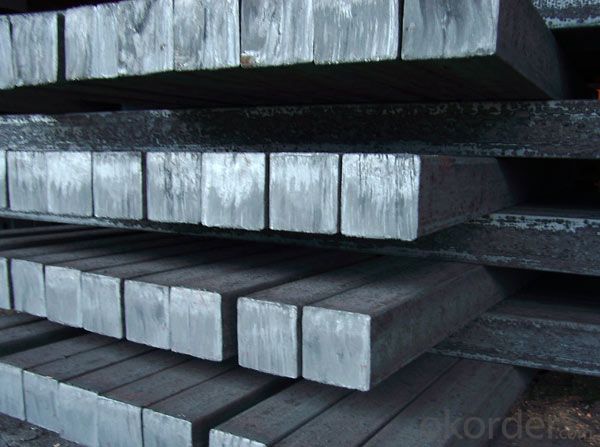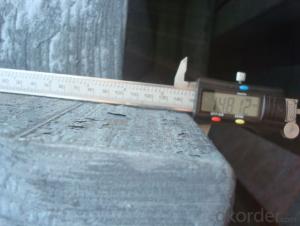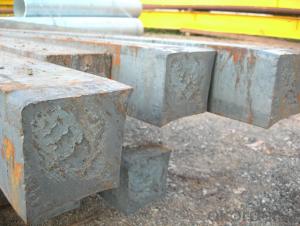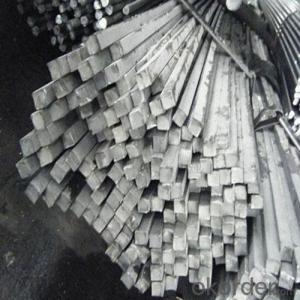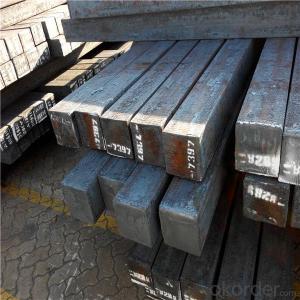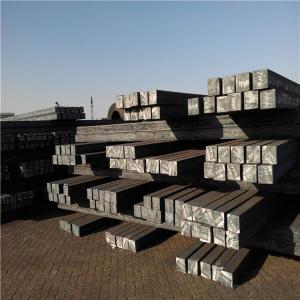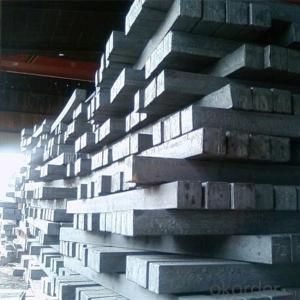Carbon Steel Billets Square Billets High Quality
- Loading Port:
- Tianjin
- Payment Terms:
- TT OR LC
- Min Order Qty:
- 24 m.t.
- Supply Capability:
- 24000 m.t./month
OKorder Service Pledge
OKorder Financial Service
You Might Also Like
Specifications
square steel billets 3sp & 5sp grade
1.3SP, 5SP
2.terms of payment: L/C at sight
3.size: 50~150mm
4.length: 5.8~12m
Specifications
| product name | square steel billets 3sp & 5sp grade |
| main types |
|
| size |
|
| application | 1.M.S. Billets are used for rolling of TMT Re-Bars of Fe415 and Fe500 Grade and various other structural steel products. 2.CRS Billets are used fro rolling of CRS TMT Re-Bars. 3.Special Alloy Billets are used for rolling of any special grade TMT Re-Bars like Earthquake resistant TMT Re-Bars and for special grade structural steel products. |
| notes | We produce world class quality steel billets which meets the specific requirements of the clients |
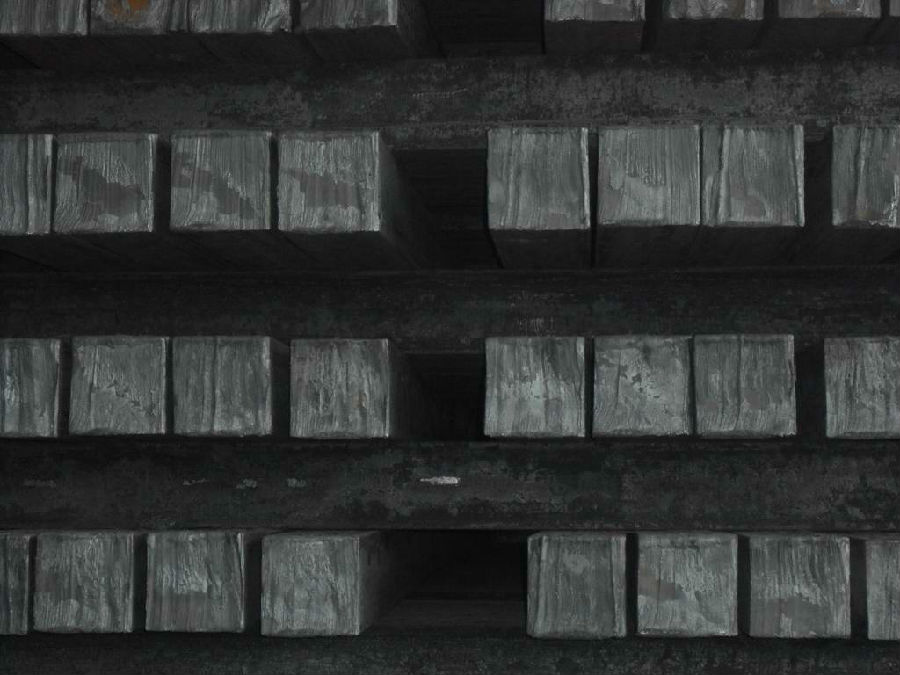
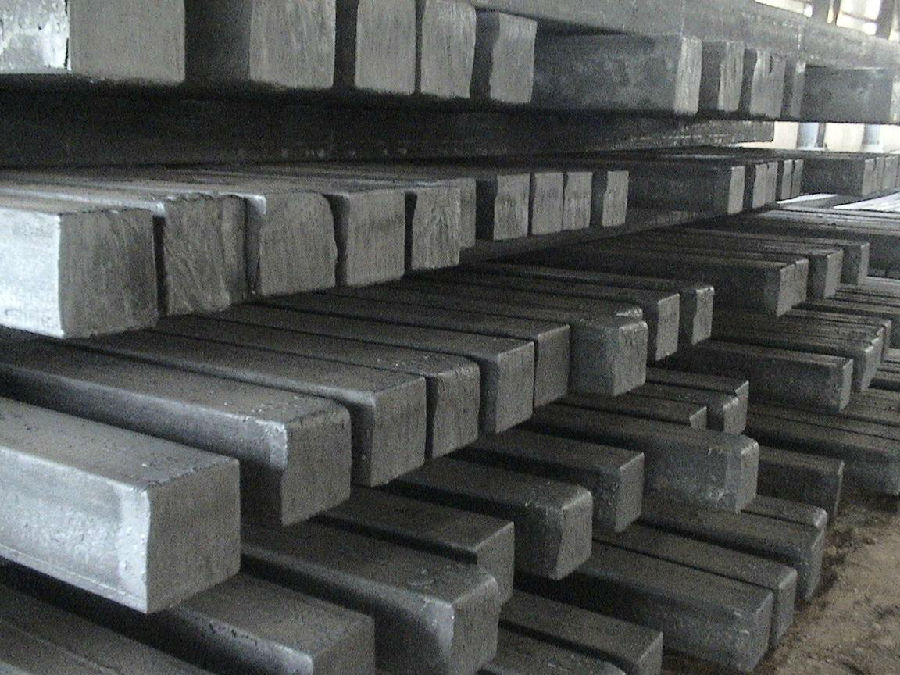
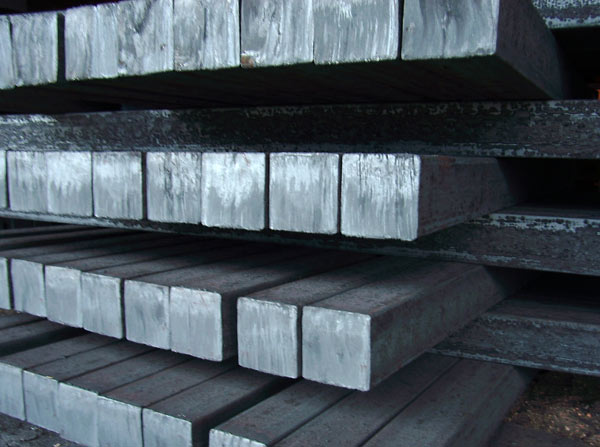
- Q: How are steel billets labeled for identification purposes?
- To identify steel billets, a combination of alphanumeric codes and markings are utilized. These labels contain vital data regarding the billet's composition, size, and other significant particulars. The most prevalent approach to label steel billets involves directly stamping or engraving the necessary information onto the billet's surface. This includes details like steel grade, heat number, lot number, and the manufacturer's symbol or logo. These markings are typically made using durable and legible industrial-grade ink or via electrochemical etching, ensuring their resilience even in harsh environments. Additionally, steel billets may also carry identification tags or labels that offer additional information which cannot be easily engraved or stamped. These tags or labels may feature barcodes, QR codes, or RFID tags, allowing for quick access to relevant information through specialized equipment. By employing these labeling methods, steel billets can be easily identified, tracked, and monitored throughout their lifespan. This ensures effective quality control, inventory management, and efficient production processes within the steel industry.
- Q: What are the potential applications of steel billets in the automotive aftermarket?
- Steel billets have numerous potential applications in the automotive aftermarket. They can be used to manufacture various critical components such as engine parts, suspension systems, and drivetrain components. Additionally, steel billets can be utilized to fabricate customized performance parts, enhancing the overall performance and durability of vehicles. Their versatility and strength make them a valuable resource for meeting the diverse needs of the automotive aftermarket industry.
- Q: Are there any international standards for steel billets?
- Indeed, steel billets are subject to international standards. The International Organization for Standardization (ISO) has formulated multiple standards that outline the prerequisites and specifications for steel billets. ISO 683-2 stands out as the most widely utilized ISO standard for steel billets, as it delineates the technical delivery requirements for hot-rolled steel bars, sections, and billets intended for general engineering applications. Moreover, the American Society for Testing and Materials (ASTM) has also established its own set of standards for steel billets, exemplified by ASTM A615/A615M. This particular standard specifies the criteria for deformed and plain carbon-steel bars designed for concrete reinforcement. These global standards ensure that steel billets, produced and traded worldwide, fulfill the essential quality and performance criteria, thereby fostering uniformity and compatibility within the industry.
- Q: How are steel billets used in the manufacturing of bars and rods?
- Steel billets are an integral component in the manufacturing process of bars and rods. These billets, which are cylindrical in shape, serve as the starting point for producing various types of bars and rods. To begin with, steel billets are often made through a process called continuous casting. This involves pouring molten steel into a mold, which then solidifies and forms a billet. The billets are typically heated to a specific temperature to improve their workability and reduce the risk of cracking during subsequent processes. Once the billets are prepared, they are sent to rolling mills where they are subjected to intense pressure and high temperatures. This process, known as hot rolling, involves passing the billet through a series of rollers to gradually shape it into the desired form. The rolling mills can be equipped with different types of rolls, such as flat rolls or grooved rolls, depending on the specific requirements of the bar or rod being produced. During the hot rolling process, the billet is elongated and reduced in cross-sectional area, resulting in a longer and thinner product. This transformation allows for the production of bars and rods with consistent dimensions and improved mechanical properties. The hot rolling process also refines the grain structure of the steel, enhancing its strength and toughness. After hot rolling, the bars or rods may undergo further processes to achieve specific characteristics. These additional processes may include quenching and tempering, which aim to optimize the mechanical properties of the final product, such as hardness and ductility. In summary, steel billets play a crucial role in the manufacturing of bars and rods. They are transformed through the hot rolling process to achieve the desired shape, dimensions, and mechanical properties. The versatility of steel billets allows for the production of a wide range of bars and rods used in various industries, including construction, automotive, and manufacturing.
- Q: What is the lifespan of a steel billet?
- The lifespan of a steel billet can vary depending on several factors such as the quality of the steel, the conditions in which it is stored and used, and the specific application it is being used for. Generally, steel billets are designed to have a long lifespan and can be used for many years without significant degradation. Steel billets are typically made from high-quality steel that is specifically engineered to have excellent strength, durability, and resistance to corrosion. This ensures that the billet can withstand the rigors of various industrial processes and applications. In terms of storage and usage conditions, steel billets need to be stored in a dry and controlled environment to prevent moisture and other contaminants from causing rust or degradation. They should also be handled and transported carefully to prevent any physical damage that could compromise their integrity. The lifespan of a steel billet also depends on the specific application it is being used for. Some billets are used in high-stress applications such as construction, automotive manufacturing, or heavy machinery, where they may undergo significant wear and tear. In these cases, the lifespan of the billet can be shorter compared to less demanding applications. Overall, with proper care, maintenance, and adherence to recommended usage guidelines, a steel billet can have a long lifespan ranging from several years to decades. Regular inspections, maintenance, and replacement of worn or damaged billets are essential to ensure optimal performance and safety in various industries.
- Q: How are steel billets heat-treated?
- Steel billets are heat-treated using a process called annealing or quenching and tempering. Annealing involves heating the steel billets to a specific temperature and then slowly cooling them down. This process helps to relieve any internal stresses and improve the overall ductility and toughness of the steel. Quenching and tempering, on the other hand, involves heating the steel billets to a high temperature and then rapidly cooling them by immersing them in a quenching medium, such as water or oil. This rapid cooling creates a hard and brittle structure in the steel, which is then tempered by reheating the billets to a lower temperature. This tempering process helps to reduce the brittleness and increase the toughness of the steel billets. The specific heat treatment process used depends on the desired properties and applications of the steel billets.
- Q: What is the role of steel billets in the automotive industry?
- Steel billets are of utmost importance in the automotive industry as they are crucial in the production of various vehicle components and parts. Essentially, steel billets are semi-finished steel products that undergo further processing to achieve the desired shape and size necessary for automotive applications. One primary application of steel billets in the automotive sector is in the production of engine and transmission components. These components, including crankshafts, connecting rods, camshafts, gears, and others that require high strength and durability, rely on steel billets as raw material for forging or casting. This ensures that they can withstand the demanding conditions of engine operation. Another significant use of steel billets in the automotive industry is for the manufacturing of structural components. These components, such as chassis frames, suspension parts, and body panels, need to possess high strength and stiffness to provide safety and rigidity to the vehicle. Steel billets undergo various techniques like hot rolling, cold rolling, or extrusion to produce the necessary forms and shapes required for these structural components. Furthermore, steel billets are also employed in the production of essential fasteners like bolts, nuts, and screws, which are crucial for assembling different parts of the vehicle. These fasteners must possess excellent tensile strength and resistance to vibration and corrosion, making steel billets an ideal choice for their manufacture. Additionally, steel billets find application in the production of various other automotive components, including axles, wheel hubs, brake discs, and steering system parts. All these components require the superior mechanical properties offered by steel billets, such as high strength, toughness, and resistance to wear and tear. In conclusion, steel billets play a vital role in the automotive industry as they serve as raw material for the production of engine and transmission components, structural components, fasteners, and other crucial parts. Their exceptional mechanical properties make them an ideal choice for applications that demand high strength, durability, and reliability, ensuring the safety and performance of vehicles on the road.
- Q: How are steel billets used in the manufacturing of automotive parts?
- Steel billets are used in the manufacturing of automotive parts by being heated and shaped into various forms such as rods, bars, and sheets. These billets serve as the raw material for forging, casting, and machining processes, enabling the production of critical components like engine blocks, crankshafts, suspension systems, and chassis. The high strength and durability of steel make it an ideal choice for automotive applications, ensuring the safety and performance of vehicles.
- Q: What are the potential applications of steel billets in the food and beverage aftermarket?
- Steel billets have limited applications in the food and beverage aftermarket due to their inherent properties and composition. However, they can be used in certain non-direct contact applications such as equipment fabrication, machinery parts, or structural components in food processing facilities. These billets can provide strength, durability, and stability, contributing to the overall infrastructure and functionality of the food and beverage industry.
- Q: What is the role of steel billets in the construction industry?
- Steel billets play a crucial role in the construction industry as they serve as the raw material for manufacturing various steel products. These solid, semi-finished forms of steel are typically used in the production of beams, bars, rods, and other structural components. By providing strength, durability, and flexibility to structures, steel billets contribute significantly to the overall integrity and safety of buildings, bridges, and other infrastructure projects.
Send your message to us
Carbon Steel Billets Square Billets High Quality
- Loading Port:
- Tianjin
- Payment Terms:
- TT OR LC
- Min Order Qty:
- 24 m.t.
- Supply Capability:
- 24000 m.t./month
OKorder Service Pledge
OKorder Financial Service
Similar products
Hot products
Hot Searches
Related keywords



